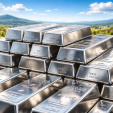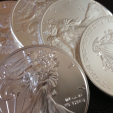Historic Silver - Headed for Higher Ground
With the rise in silver prices these past two years, silver is becoming an ever-more attractive and exciting metal to investors. This is not fluke. Many understand that although the price has risen in U.S. dollar terms, the true gain has not been significant yet! Since the U.S. dollar has almost constantly been losing purchasing power these past several years, price alone does not tell the full story. In fact recently a reader asked if they were too late to enjoy any further appreciation in silver's value. Silver is merely getting started in terms of how well it will perform not only against the U.S. dollar but all currencies eventually.
Given where silver has been and where I think it's headed, I thought I would take the opportunity, below, to present some history about silver to explain why I am so confident in silver's performance today, and even more optimistic for tomorrow.
Sometimes, we get carried away with our current investment situations and lose track of the "bigger picture." We start to think that every tick upward is a countdown to an immediate explosion in price, and that every downward move presages a drop to low and disappointing prices. Living in the moment, as we often are, we are all guilty of this from time to time.
Of course there are plenty who will encourage the latter view. The kind of price rise that silver has been enjoying, and gold too, are "dead-cat bounces" if you believe many on Wall Street.
This is where knowledge of history is helpful. Wall Street won't ever explain to you that silver has been a valuable metal for thousands of years, as much as 10,000, 15,000 or even 20,000. It's malleable, useful, and is satisfying to the touch and beautiful to look at. People almost instinctually understand this.
Since most on Wall Street won't explain it to you, even if they knew it themselves, you need to understand silver's history for yourself. You need to read up on it and bear in mind some basic, historical truths. Understand silver's history and you can put the inevitable ups and downs of the market into perspective and tolerate more price volatility. Silver has been around a lot longer than you have. It will still be sought after, and gaining value in a fiat-money system, long after you are gone.
THREE POINTS FOR SILVER
When examining silver as a valuable investment today, one should keep in mind the following points.
Monetary function: Silver has had a monetary function far longer than gold, being used as the most common medium of exchange in everyday commerce since well before the time of Christ. In fact, silver again lasted longer than gold as a medium of exchange (real money), surviving until 1965, whereas gold ceased to circulate among the people in 1933, being reserved for balance-of-trade payments until the gold window was closed in 1971. Silver has enormous attractiveness and staying-power when it comes to free-market monetary decisions - and no doubt if people were free to circulate whatever kind of money they chose, silver would again become the common man's first choice.
Store of value: It is also worth noting that in a true gold standard, many financial planners would be out of business. As absurd as this sounds, follow the logic. If the monetary system were based on honest weights and measures, you would know, when you first entered the work force at, say, 20 years of age, exactly how much you would need to save by age 65 for retirement. Why? Because your purchasing power would remain constant. Under an honest monetary system, interest rates are stable and long-range planning is simplified. In a true gold standard, purchasing power actually increases slightly over time so that an ounce of gold would buy slightly more after 35 years than it did when you originally entered the work force. For thousands of years, silver has held its value, becoming steadily more useful as an industrial metal while retaining its position as a precious metal second only to gold.
Undervalued status today: In consideration of silver's monetary role, we need to examine historic ratios between the values of gold and silver. Historically, silver was valued at approximately 1/12 the price of gold or what I call the natural ratio. Once silver and gold were both used as money, silver was 1/16th the price of gold. This is what I refer to as the "classic" ratio or monetary ratio. This 1/16 ratio held from 1700 to 1860, one hundred and sixty years. Only in recent history has the gold/silver ratio risen above the "classic" 16:1. If we use the classic ratio, then one troy ounce of silver would be over $25 USD with gold at $450USD. This seems crazy, but it actually is normal from a historic point of view. A menu in the 1850s might offer a meal for 5 cents. If you worked as a miner during the great silver rush in Virginia City (Comstock Lode), you were paid two silver dollars per day as wages. The five cents would be 1/40th of a day's wage. Taking that to the present time, a person making $5.00 an hour ($40 a day) is able to buy a 99-cent hamburger at several fast food outlets. This is equivalent to the 1/40th comparison. Looked at historically, silver has a long way to travel up once a breakout begins.
THE TRIGGER?
Silver's value is pent up and steady market pressure will unlock it over time. Whether the value is realized all at once - highly doubtful - or over a period of months and years, no one can say with any accuracy. But as my little historical overview above shows, the reality of silver's value and its erratic upward moves in the last few years are no flukes. Silver is volatile but the major trend is up and we are very early in the major trend.
Where might the trigger lie this time? Probably what will trigger a substantial move in the market is industrial silver demand from China - a vast country in the throes of a compressed industrial revolution.
In a recent article, I referred to the industrial pressure from China plus inflationary pressures around the world as the "Silver Trap" - and concluded that: "Silver is going through the roof, in my opinion, because of the twin pressures of inflation and industrial demand and increasing industrial demand from China. More than gold, silver is going to come under pressure because it is an industrial as well as precious metal."
I also wrote, "We are on the cusp of breaking out of the Silver Trap - and the force of the explosion may be mighty indeed. The twin drivers of inflation and high demand are providing the fuel, and the takeoff is underway. The market is a mighty force and cannot be denied - not now, not as it affects the silver market, indeed the precious metals markets in general."
No one can predict how long it will take for silver to reach its true value, but almost everyone, when confronted with the facts will admit that silver is a long way from that point yet. Usually it takes protracted bear markets - commodity markets - several years to reattach silver (or gold) to a realistic market price.
Are we in such a market? Yes, we are. The pressure on silver supplies is strong and growing more powerful every day - and the demand from Asia and from China in particular for industrial silver will only continue to strengthen. The recent price rise in silver was encouraging, but even were silver to dip again, those who understand silver's history would merely look on those dips as buying opportunities.
I believe we are on the brink of a historical re-evaluation in silver prices. Those with a basic knowledge of the history of the "white metal" and its ability to retain value over time, will be the ones who will find it easiest to tolerate the entire wild ride (and it will likely last throughout this decade and maybe beyond) as silver finds newer and much - very much higher - ground.
I will close by reminding readers that in numerous other articles and white papers I have stressed that physical silver is not the only kind of way that investors position themselves for the ongoing upward movement over the next half decade. It is important for investors to invest in real silver and gold. However, the leverage in stocks, especially small mining stocks is quite extensive, if one is positioned correctly. My newsletter, the Silver Investor, contains such choices - and recently we have been focused on one opportunity in particular, in northern China.


















